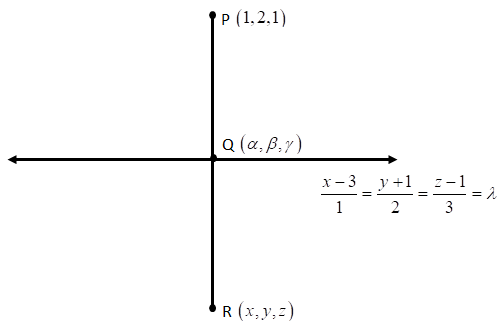Question
Question: Find the foot of perpendicular and image of point \(\left( {1,2,1} \right)\) along the line \(\dfrac...
Find the foot of perpendicular and image of point (1,2,1) along the line 1x−3=2y+1=3z−1=λ.
Solution
Here,we will draw a figure representing this situation. Then, we will find the direction ratios of the line. As both the lines are perpendicular to each other, we will be able to find the value of λ. Using this we will find the required coordinates of the foot of the perpendicular which could be used as a midpoint to find the coordinates of the image of the given point.
Formula Used:
We will use the following formulas:
1. If an equation of a line is given by dx−a=ey−b=fz−c=k.
Then, (d,e,f) represents the direction ratios of the given line
2. The direction ratios of a line passing through two points (p,q,r) and (x,y,z) is given by (x−p,y−q,z−r).
3. If two lines are perpendicular to each other, then, the sum of product of their direction ratios is 0.
4. Coordinates of the mid-point Q is given as 2x1+x2,2y1+y2,2z1+z2.
Complete step-by-step answer:
Given equation of line is 1x−3=2y+1=3z−1=λ
Now, we will cross multiply to find the respective values of x,y,z
Hence, we get,
x=λ+3
y=2λ−1
z=3λ+1
Now, the direction ratios of the given line are: (1,2,3) because if an equation of a line is given by
dx−a=ey−b=fz−c=k
Then, (d,e,f) represents the direction ratios of the given line
Now, we will draw a figure representing the given situation.

Now, let the coordinates of the foot of perpendicular line of the given line be Q=(α,β,γ)
Since this foot of perpendicular lies on both the lines as it is their point of intersection.
Thus, it will satisfy the given equation of the line.
Hence, substituting (x,y,z)=(α,β,γ) in the equation of the line and after cross multiplying, we get,
α=λ+3
β=2λ−1
λ=3λ+1………………………………….(1)
Now, the direction ratios of a line passing through two points (p,q,r) and (x,y,z) is given by (x−p,y−q,z−r)
Since, the perpendicular line consists of the given point M(1,2,1) and it also passes through the foot of perpendicular Q=(α,β,γ)
Hence, the direction ratios of the perpendicular line are: (α−1,β−2,γ−1)
Now, using the fact that if two lines are perpendicular to each other, then, the sum of product of their direction ratios is 0, we get,
1(α−1)+2(β−2)+(3)(γ−1)=0
⇒α−1+2β−4+3γ−3=0
Here, substituting the values of (α,β,γ) from (1), we get,
⇒λ+3−1+2(2λ−1)−4+3(3λ+1)−3=0
⇒λ+2+4λ−2−4+9λ+3−3=0
Solving further, we get,
⇒14λ−4=0
Dividing both sides by 2
⇒7λ−2=0
Adding 2 on both sides
⇒7λ=2
And, dividing both sides by 7, we get,
⇒λ=72
Substituting this value in (1), we get,
α=72+3=723
β=2(72)−1==74−1=7−3
λ=3(74)+1=712+1=719
Therefore, the coordinates of foot of perpendicular are (α,β,γ)=(723,7−3,719)
Now, if the coordinates of the image of the given point is R=(x,y,z)
Then, we know that the foot of perpendicular should be the midpoint of the perpendicular line PR.
Hence, coordinates of the mid-point Q will be:
2x1+x2,2y1+y2,2z1+z2
Here, substituting (x1,y1,z1)=(1,2,1) and (x2,y2,z2)=(x,y,z)
⇒ Coordinates of the mid-point Q will be 21+x,22+y,21+z
But, the coordinates of foot of perpendicular Q=(723,7−3,719)
Hence, we get,
(723,7−3,719)=(21+x,22+y,21+z)
After comparing, we get,
723=21+x
⇒7x+7=46
Subtracting 7 from both sides, we get
⇒7x=39
Dividing both sides by 7, we get
⇒x=739
Similarly,
7−3=22+y
⇒7y+14=−6
Subtracting 14 from both sides, we get
⇒7y=−20
Dividing both sides by 7, we get
⇒y=7−20
Also,
719=21+z
⇒7z+7=38
Subtracting 7 from both sides, we get
⇒7z=31
Dividing both sides by 7, we get
⇒z=731
Therefore, the coordinates of the image of the given point R=(739,7−20,731)
Hence, the foot of perpendicular and image of point (1,2,1) along the line 1x−3=2y+1=3z−1=λ are (723,7−3,719) and (739,7−20,731) respectively.
Thus, this is the required answer.
Note:
When two lines meet or intersect each other at right angles or 90 degrees, they are said to be perpendicular to each other. Now, when a point is being reflected on a mirror or a line then, the distance of the point from the line is equal to the distance of its image behind the line. Thus, the point of intersection or the foot of perpendicular turns out to be the midpoint of the line. Hence, these facts about reflection should be kept in mind while solving these types of questions.
